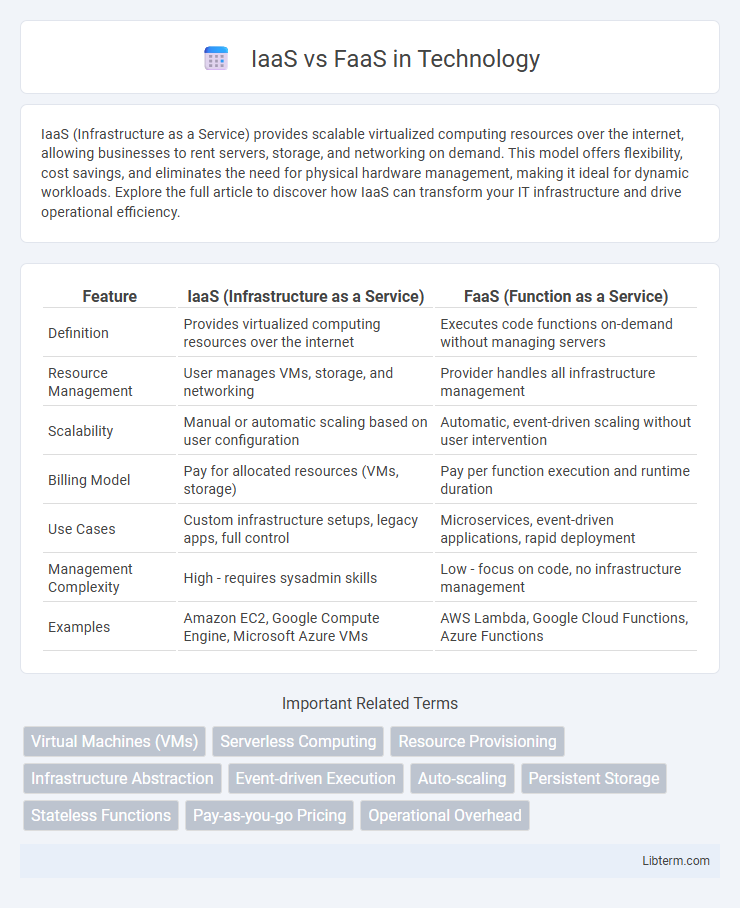IaaS (Infrastructure as a Service) provides scalable virtualized computing resources over the internet, allowing businesses to rent servers, storage, and networking on demand. This model offers flexibility, cost savings, and eliminates the need for physical hardware management, making it ideal for dynamic workloads. Explore the full article to discover how IaaS can transform your IT infrastructure and drive operational efficiency.
Table of Comparison
| Feature | IaaS (Infrastructure as a Service) | FaaS (Function as a Service) |
|---|---|---|
| Definition | Provides virtualized computing resources over the internet | Executes code functions on-demand without managing servers |
| Resource Management | User manages VMs, storage, and networking | Provider handles all infrastructure management |
| Scalability | Manual or automatic scaling based on user configuration | Automatic, event-driven scaling without user intervention |
| Billing Model | Pay for allocated resources (VMs, storage) | Pay per function execution and runtime duration |
| Use Cases | Custom infrastructure setups, legacy apps, full control | Microservices, event-driven applications, rapid deployment |
| Management Complexity | High - requires sysadmin skills | Low - focus on code, no infrastructure management |
| Examples | Amazon EC2, Google Compute Engine, Microsoft Azure VMs | AWS Lambda, Google Cloud Functions, Azure Functions |
Understanding IaaS: Definition and Core Features
Infrastructure as a Service (IaaS) provides virtualized computing resources over the internet, offering scalable storage, networking, and processing power without physical hardware management. Core features of IaaS include on-demand resource allocation, automated administrative tasks, and flexible scalability to adapt to changing workloads. This model enables businesses to deploy and manage applications efficiently while maintaining control over the operating systems and middleware.
What is FaaS? Key Concepts Explained
Function as a Service (FaaS) is a cloud computing model that allows developers to run individual functions or pieces of code without managing underlying servers, enabling event-driven execution and automatic scaling. Key concepts include stateless functions, ephemeral runtime environments, and pay-per-use billing based on actual function invocations and execution time. FaaS contrasts with Infrastructure as a Service (IaaS) by abstracting infrastructure management, focusing solely on code deployment and execution triggered by events or HTTP requests.
IaaS vs FaaS: Architecture Differences
IaaS (Infrastructure as a Service) provides virtualized computing resources over the internet, allowing users to manage operating systems, middleware, and applications on scalable virtual machines. FaaS (Function as a Service) abstracts the infrastructure entirely, enabling developers to deploy individual functions that execute in response to events without managing servers or runtime environments. The key architectural difference lies in IaaS offering full control over the underlying infrastructure, while FaaS operates on a serverless model where the cloud provider handles all server management and scaling automatically.
Use Cases: When to Choose IaaS
IaaS is ideal for businesses requiring full control over their infrastructure, custom configurations, and scalable virtual machines for applications like legacy system migration or extensive storage needs. It supports workloads with unpredictable traffic, development environments, and enterprise applications demanding consistent performance and security compliance. Choosing IaaS is beneficial when direct access to operating systems, middleware, and network resources is critical for application management and optimization.
Use Cases: When to Opt for FaaS
FaaS is ideal for event-driven applications, microservices architectures, and real-time data processing where scalability and cost efficiency are critical. It excels in scenarios requiring rapid deployment, automatic scaling, and minimal infrastructure management, such as API backends, IoT data ingestion, and asynchronous task execution. Choosing FaaS over IaaS benefits developers focused on reducing operational overhead while handling variable workloads and short-lived processes.
Scalability Comparison: IaaS and FaaS
IaaS (Infrastructure as a Service) offers scalability through virtual machines and resource allocation, enabling users to manually adjust compute, storage, and network capacity based on demand. FaaS (Function as a Service) provides automatic, event-driven scalability where functions scale instantly in response to incoming requests without user intervention. FaaS typically delivers finer-grained scaling with faster elasticity, making it ideal for unpredictable workloads compared to the more controlled and customizable scaling options in IaaS.
Cost Analysis: IaaS vs FaaS Pricing Models
IaaS pricing models typically charge based on allocated resources such as CPU, memory, and storage over time, leading to predictable monthly costs but potential underutilization expenses. FaaS employs a pay-as-you-go model that bills users only for actual execution time and resource consumption, offering cost efficiency for variable workloads with irregular traffic. Understanding these differences helps businesses optimize expenses by matching their application demands to the most suitable cloud service model.
Security Considerations in IaaS and FaaS
Security considerations in IaaS involve managing virtual machines, networks, and storage with a focus on securing operating systems, patch management, and strong identity and access controls. FaaS security emphasizes securing function code, runtime environments, and preventing unauthorized access through fine-grained permissions and event-based triggers. Both models require robust encryption, continuous monitoring, and compliance with industry standards to mitigate vulnerabilities and ensure data protection.
Performance and Latency: Which is Better?
IaaS delivers consistent performance with dedicated virtual machines, optimized for steady workloads requiring predictable latency and higher control over resource allocation. FaaS offers event-driven execution with automatic scaling, excelling in handling bursty, unpredictable workloads but may experience cold start latency impacting overall response time. Performance superiority depends on workload characteristics, where IaaS suits latency-sensitive applications and FaaS is ideal for highly scalable, intermittent tasks.
Future Trends: The Evolving Role of IaaS and FaaS
IaaS is evolving to integrate advanced automation and AI-driven resource management, enhancing scalability and cost efficiency for enterprises. FaaS is increasingly adopted for event-driven architectures, enabling developers to deploy microservices with minimal operational overhead and rapid scalability. Future trends indicate a hybrid approach where businesses leverage IaaS for foundational infrastructure while using FaaS to optimize specific functions and workloads dynamically.
IaaS Infographic

 libterm.com
libterm.com